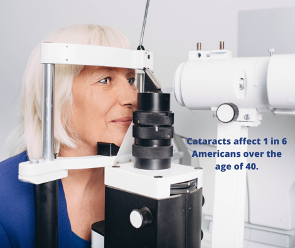Home » Blog » What Are Cataracts?
What Are Cataracts?
Posted by: South Georgia / North Florida Eye Partners in News

According to the American Academy of Ophthalmology, a cataract is a dense, cloudy area that forms in the lens of the eye. A cataract begins when proteins in the eye form clumps that prevent the lens from sending clear images to the retina. The retina works by converting the light that comes through the lens into signals. It sends the signals to the optic nerve, which carries them to the brain. A cataract develops slowly and eventually interferes with your vision. You might end up with cataracts in both eyes, but they usually don’t form at the same time.
What Causes Cataracts?
Aging is the most common cause. Did you know that in the US alone, cataracts affect over 20 million adults 40 and older and half of all seniors age 80 and up? This is due to normal eye changes that happen to start around age 40. That is when normal proteins in the lens begin to break down, which causes the lens to get cloudy. People over age 60 usually start to have some clouding of their lenses. However, vision problems may not happen until years later.
Other reasons you may get cataracts include:
- Genetics – having parents, brothers, sisters, or other family members who have cataracts
- Certain medical problems, such as diabetes
- Smoking
- Having had an eye injury, eye surgery, or radiation treatments on your upper body
- Having spent a lot of time in the sun, especially without sunglasses that protect your eyes from damaging ultraviolet (UV) rays
- Using certain medications, such as corticosteroids, which may cause the early formation of cataracts.
Most age-related cataracts develop gradually. Other cataracts can develop more quickly, such as those in younger people or those in people with diabetes.
Cataract Symptoms
Listed below are some vision changes you may notice if you have a cataract:
- Having blurry vision
- Seeing double (when you see two images instead of one)
- Being extra sensitive to light
- Having trouble seeing well at night, or needing more light when you read
- Seeing bright colors as faded or yellow instead
How To Slow Down Your Development Of Cataracts
Protecting your eyes from sunlight is the best way to do this. Wear sunglasses that screen out the sun’s ultraviolet (UV) light rays. You may also wear regular eyeglasses that have a clear, anti-UV coating. Talk with your eye doctor to learn more.
Experiencing Cataract Symptoms?
If you have noticed changes to your vision like the symptoms we listed above, it is a good idea to come in for an eye exam. In this modern age of incredible medical advancements, there is no reason to ignore your eye health. Give us a call today to learn more or to schedule an appointment!
229.244.2068
